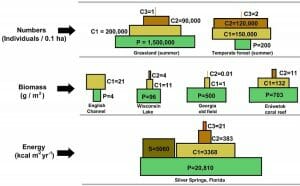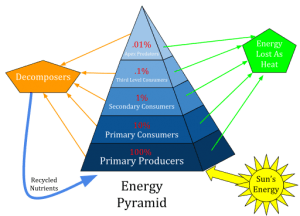Ecological Pyramid Definition
An ecological pyramid is a graphical representation of the relationship between different organisms in an ecosystem. Each of the bars that make up the pyramid represents a different trophic level, and their order, which is based on who eats whom, represents the flow of energy. Energy moves up the pyramid, starting with the primary producers, or autotrophs, such as plants and algae at the very bottom, followed by the primary consumers, which feed on these plants, then secondary consumers, which feed on the primary consumers, and so on. The height of the bars should all be the same, but the width of each bar is based on the quantity of the aspect being measured.
Types of Ecological Pyramids
Pyramid of numbers
This shows the number of organisms in each trophic level without any consideration for their size. This type of pyramid can be convenient, as counting is often a simple task and can be done over the years to observe the changes in a particular ecosystem. However, some types of organisms are difficult to count, especially when it comes to some juvenile forms. Unit: number of organisms.
Pyramid of biomass
This indicates the total mass of organisms at each trophic level. Usually, this type of pyramid is largest at the bottom and gets smaller going up, but exceptions do exist. The biomass of one trophic level is calculated by multiplying the number of individuals in the trophic level by the average mass of one individual in a particular area. This type of ecological pyramid solves some problems of the pyramid of numbers, as it shows a more accurate representation of the amount of energy contained in each trophic level, but it has its own limitations. For example, the time of year when the data are gathered is very important, since different species have different breeding seasons. Also, since it’s usually impossible to measure the mass of every single organism, only a sample is taken, possibly leading to inaccuracies. Unit: g m-2 or Kg m-2.
Pyramid of productivity
The pyramid of productivity looks at the total amount of energy present at each trophic level, as well as the loss of energy between trophic levels. Since this type of representation takes into account the fact that the majority of the energy present at one trophic level will not be available for the next one, it is more accurate than the other two pyramids. This idea is based on Lindeman’s Ten Percent Law, which states that only about 10% of the energy in a trophic level will go towards creating biomass. In other words, only about 10% of the energy will go into making tissue, such as stems, leaves, muscles, etc. in the next trophic level. The rest is used in respiration, hunting, and other activities, or is lost to the surroundings as heat. What’s interesting, however, is that toxins are passed up the pyramid very efficiently, which means that as we go up the ecological pyramid, the amount of harmful chemicals is more and more concentrated in the organisms’ bodies. This is what we call biomagnification.
The pyramid of productivity is the most widely used type of ecological pyramid, and, unlike the two other types, can never be largest at the apex and smallest at the bottom. It’s an important type of ecological pyramid because it examines the flow of energy in an ecosystem over time. Unit: J m-2 yr-1, where Joule is the unit for energy, which can be interchanged by other units of energy such as Kilojoule, Kilocalorie, and calorie.
While a productivity pyramid always takes an upright pyramid shape, number pyramids are sometimes inverted, or don’t take the shape of an actual pyramid at all. To demonstrate, let’s take an oak tree, which can feed millions of oakworms. If we consider this ecosystem as our focus, then the producers’ level (one tree) will end up much smaller than the primary consumers’ level (millions of insects). This is less likely to occur in biomass pyramids, but is not impossible. The pyramids below show the different types of pyramids and the shapes they can have in different ecosystems.
Ecological Pyramid Examples
The diagram below is an example of a productivity pyramid, otherwise called an energy pyramid. The sun has been included in this diagram, as it’s the main source of all energy, as well the decomposers, like bacteria and fungi, which can acquire nutrients and energy from all trophic levels by breaking down dead or decaying organisms. As shown, the nutrients then go back into the soil and are taken up by plants.
The loss of energy to the surroundings is also shown in this diagram, and the total energy transfer has been calculated. We start off with the total amount of energy that the primary producers contain, which is indicated by 100%. As we go up one level, 90% of that energy is used in ways other than to create flesh. What the primary consumers end up with is just 10% of the starting energy, and, 10% of that 10% is lost in the transfer to the next level. That’s 1%, and so on. The predators at the apex, then, will only receive 0.01% of the starting energy! This inefficiency in the system is the reason why productivity pyramids are always upright.
Function of Ecological Pyramid
An ecological pyramid not only shows us the feeding patterns of organisms in different ecosystems, but can also give us an insight into how inefficient energy transfer is, and show the influence that a change in numbers at one trophic level can have on the trophic levels above and below it. Also, when data are collected over the years, the effects of the changes that take place in the environment on the organisms can be studied by comparing the data. If an ecosystem’s conditions are found to be worsening over the years because of pollution or overhunting by humans, action can be taken to prevent further damage and possibly reverse some of the present damage.
Related Biology Terms
- Trophic level – The position that an organism occupies within a food chain or an ecological pyramid, such as a producer, or a primary consumer. Many animals feed at several different trophic levels.
- Species – A group of organisms that exhibit common characteristics and can breed among themselves to produce fertile offspring.
- Ecosystem – A community of interdependent living organisms in association with the nonliving elements surrounding them. The way the living organisms and the physical environment interact is by exchange of nutrients and energy.
- Food web – A system of food chains that are interlocked with one another. Unlike in food chains, an organism in a food web can occupy several different trophic levels.
Quiz
1. Why is it unusual for a large number of organisms to be present at the top of an ecological pyramid?
A. Animals at the top of the pyramid are the largest.
B. Animals at the top have shorter lives.
C. The amount of energy available by the time the top of the pyramid is reached is not enough to sustain many individuals.
D. Humans are most interested in hunting animals occupying the top level of the ecological pyramid.
2. The biomass of an ecosystem is:
A. The total energy of living and nonliving components of the ecosystem.
B. The total energy of living organisms in an ecosystem.
C. The total mass of living and nonliving components of the ecosystem.
D. The total mass of living organisms in an ecosystem.
3. If the producers in ecological pyramid have a total of 80000 Kcal of energy, which of the following would be true?
A. The secondary consumers would have a total of 80 Kcal of energy.
B. The tertiary consumers would have a total of 8 Kcal of energy.
C. The secondary consumers would have a total of 80000 Kcal of energy.
D. The tertiary consumers would have a total of 80 Kcal of energy.


